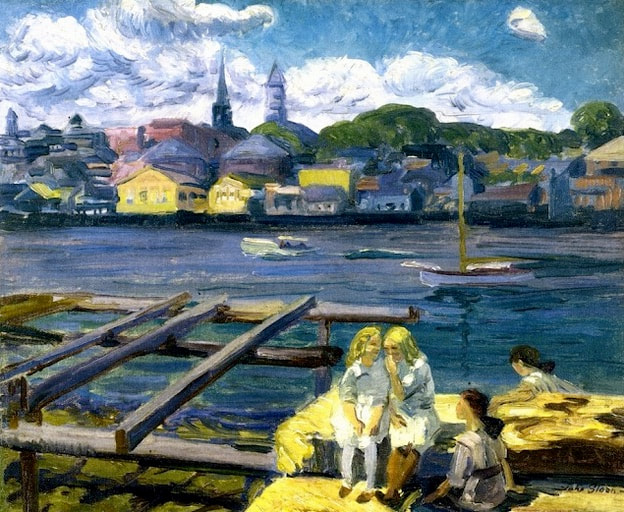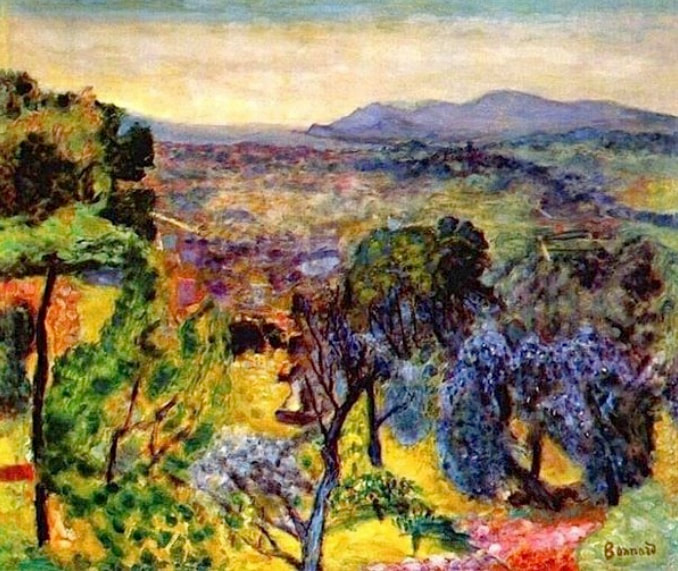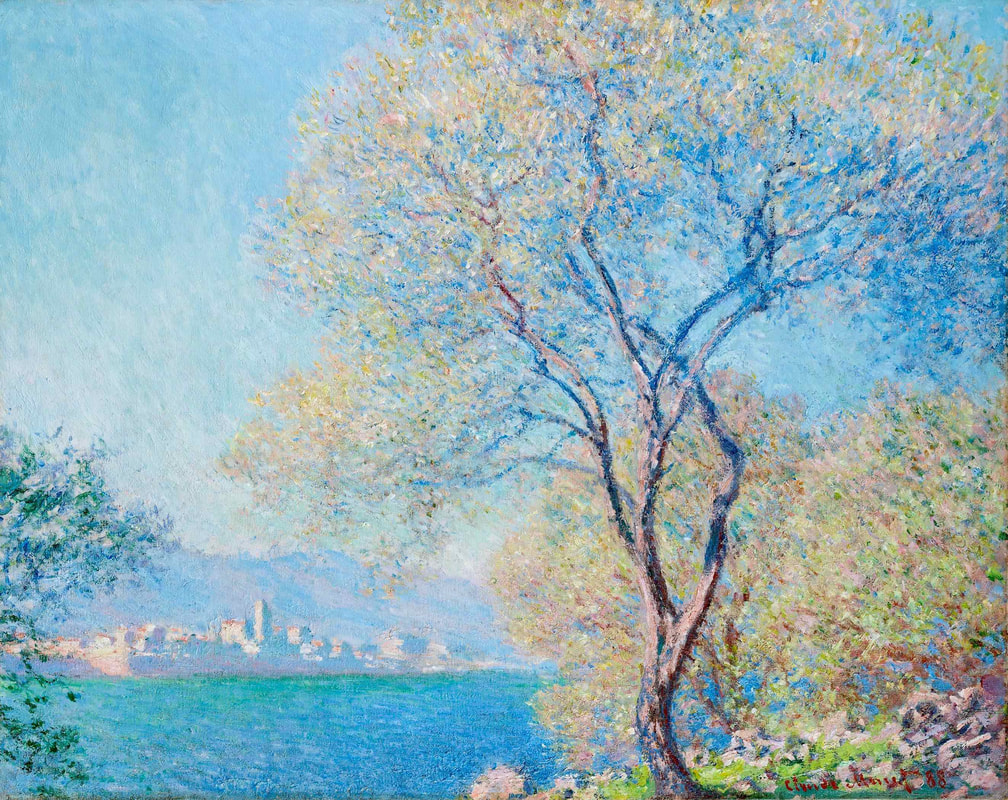|
Camille Pissarro, Entrance to the Village of Voisins, 1872; © Musée d'Orsay. The original of this Pissarro painting is beautifully naturalistic, full of subtlety and life. Its carefully composed view — titled in French "Entrée du Village de Voisins" — gives you a sort of "you are there" sensation, as though you can almost smell the earth, and feel the coolness of the air. Sadly, the oddly colored, quickly executed reproduction shown below lacks all of these qualities, and fails to capture the depth, emotion, and seasonal details of the authentic work. Altered reproduction of a painting by Camille Pissarro. Corrections or suggestions?
0 Comments
Vincent van Gogh, Houses and Figure, 1890; The Barnes Foundation. This vibrant Van Gogh painting, with so much color, forcefulness and dynamic flow, as been reduced to a flat, yellowish sketch in the modern reproduction shown below. The pink sky is very unusual in Van Gogh's work, so it would seem important to retain at least that element of this particular painting. But it's missing in the revised copy. Some of the posts that include the pale reproduction also have added the long and incorrect title, "Thatched Cottages in the Sunshine Reminiscence [sic] of the North." This appears to be a summary of notes about the painting rather than the actual name of the piece. Here's a blurb from the Barnes listing, which includes the information in narrative form: Van Gogh painted this landscape during the last year of his life, when he was a patient at the asylum in Saint-Rémy, near Arles, in the South of France. With limited access to the outdoors, Van Gogh had to paint what could be seen out the window — or, as is the case here, what he could picture in his mind. This painting is a remembrance of his native Netherlands, showing the thatched cottages that dotted the Dutch landscape. Altered version of a painting by Vincent van Gogh. Édouard Manet, "The Folkestone Boat, Boulogne," c.1868-72; The Philadelphia Museum of Art. At first glance, the reproduction below (possibly a digitally altered image) doesn't look much different from the original. But a closer examination reveals that excessive contrast has erased a lot of beautiful detail. It's a shame, because the first-hand photo seen above is easily available at the website of the Philadelphia Museum of Art, where the painting is located. No need to make changes; the authentic painting is bright, colorful, compelling, and full of movement "as is." Altered version of a painting by Edouard Manet. John French Sloan, Tittering Girls, 1914; private collection. The color changes in the reproduction shown below of John Sloan's Tittering Girls are fairly extreme, and include several randomly yellow objects in the foreground and distance. Not only that, but the composition is reversed. Possibly the contemporary artist was looking in a mirror or was working from a photo that had already been flipped. In any case, the new version differs significantly from the original, where the coloring, brushwork, contrast and naturalistic details reflect the artist's usual style. There are very few examples of the painting available, probably because it's rarely seen in public. The photo above is from a 1999 exhibition at the Georgia Museum of Art. Unfortunately, the lack of authentic images has led many art fans to adopt the vastly different reproduction as the standard for this artwork. Altered, reversed reproduction of a painting by John Sloan. THE ART DETECTIVE Bloopers, Fakes & Mistakes
Pierre Bonnard, Cannet Landscape, c.1925, private collection. Photo: © Sotheby's. Lots of color changes in the modern reproduction below, with added contrast that blurs many of the details. Although European landscapes of this period tend toward abstraction, they often retain a link with the natural world through the use of elements such as green trees and plants, blue sky, earth tones and so on. The reproduction seems to have ignored the painting's naturalistic qualities, altering the palette and also damaging the depth, energy flow, and emotion of the original. The image above is from Sotheby's, where the authentic work sold in 2014 for $2,045,000. Altered version of a painting by Pierre Bonnard. Claude Monet, Antibes Seen From La Salis, 1888; Toledo Museum of Art. The original Monet painting, shown above in a photo from the Toledo Museum of Art, is spectacular, with Monet's signature blues, and plays of light that were so difficult for him at the time: "I'm wrestling with the sun. And what a sun it is!" According to the museum, "His efforts to express the light and color of the Mediterranean fulfilled a promise to his companion, Alice Hoschedé, that what he would paint in Antibes would be 'sweetness itself, white, pink, blue, all of it enveloped in this fairy-tale-like air.'" Clearly, the dark and yellowish reproduction below doesn't come close to achieving these effects. And Monet's words help to confirm the relative accuracy of the museum's photo. Modern artwork based on a painting by Claude Monet. Copywriting & Consultations
Claude Monet, The Bridge at Bougival," 1869; Currier Museum of Art. It's always a shame when a beautiful work of art is randomly altered, but in this case it's particularly unfortunate, since Bridge at Bougival is one of Monet's most significant paintings. An article in the Concord Monitor about the painting's return to the Currier after a year on tour, passes along information from Andrew Spahr, the museum's director of collections and exhibitions: The true importance of [the painting] has only been revealed in the last several decades [...] Scholars now recognize [it] as a turning point in Monet's early career, in which he begins to form a new style that would transform not only his working method, but the whole of western art. The article goes on to say that art historian and Monet expert Paul Hayes Tucker, "calls the painting 'one of the great pictures,' and a real mark of Monet's achievement at that moment." The purple version below is probably an altered photo of a modern reproduction. Why change the colors or tamper with the overall look of the painting? A good photo of the original is easily accessible at the museum's website. Altered version of a painting by Claude Monet. THE ART DETECTIVE Bloopers, Fakes & Mistakes
Paul Gauguin, Breton Fishermen, 1888; Private Collection (Onyx Art Collection). One of the main reasons there are so many false art images in circulation is that a large percentage of authentic artworks are in private collections, and therefore are rarely seen or photographed. With few verified photos available, art lovers end up selecting modern reproductions instead, thinking that they're probably fairly accurate (not true, unfortunately). Based on available evidence, the above photo is very likely an accurate depiction of this Gauguin painting, which is evidently on view at a high-end resort hotel in Bahía. Few direct photos exist. The two reproductions below (possibly digitally manipulated photos) are a couple examples of ways in which users have altered the original coloring at random, in one case making everything blue and in the other obscuring detail with a yellow overlay. Note that one popular post has mistakenly titled the work "English Fishermen." Altered version of a painting by Paul Gauguin. Altered version of a painting by Paul Gauguin. Copywriting & Consultations
Gustave Caillebotte, "Dahlias, Garden at Petit Gennevilliers," 1893; National Gallery of Art, Washington, D.C. The altered image below, which as been seen online lately, and traces back to a Wiki site, is clearly a cropped and re-colored version of the original. It could be a digitally edited photo, or it might be a recently painted reproduction. Regardless, the listing doesn't mention that the image is just a portion of the real-world picture, and also mistakenly states that the painting is in a private collection. In fact, the work can be easily found at the National Gallery of Art, Washington, D.C., as shown above. Be cautious when using any of the Wiki sites. Many of the listings are uploads by ordinary people who might or might not possess full information about the photos they're adding to the database. And make sure to click through to the source — sometimes the picture that Wiki shows and the picture that's at the source don't match up! Cropped and retouched version of a painting by Gustave Caillebotte. Corrections or suggestions?
Otis Dozier, Cotton Ball, 1936; Dallas Museum of Art. The yellow-tinged reproduction below not only changes the colors of the original, but in doing so erases the naturalistic qualities that are basic to the composition despite its abstract elements. The monochrome color scheme flattens depth and contrast, and severs the connection with earth, natural growth, and blue sky. The image is most likely a photo of a recently painted reproduction, but it's been circulating without a notification letting viewers know that it's an altered update. It's also badly cropped, with sections of the top and bottom missing. Altered version of a painting by Otis Dozier. THE ART DETECTIVE Bloopers, Fakes & Mistakes
|
REAL or REPRO?
A well-researched art resource that can help you find accurate images and spot altered copies. 100+ listings and growing daily. Browse at random, or search for something specific. Special requests are welcome.
Categories
All
Archives
January 2021
Disclaimer: This blog is intended for entertainment purposes only. Although every effort has been made to verify the accuracy of the information provided, the material included here should in no way be considered the final authority on any issues discussed in the text.
|































 RSS Feed
RSS Feed